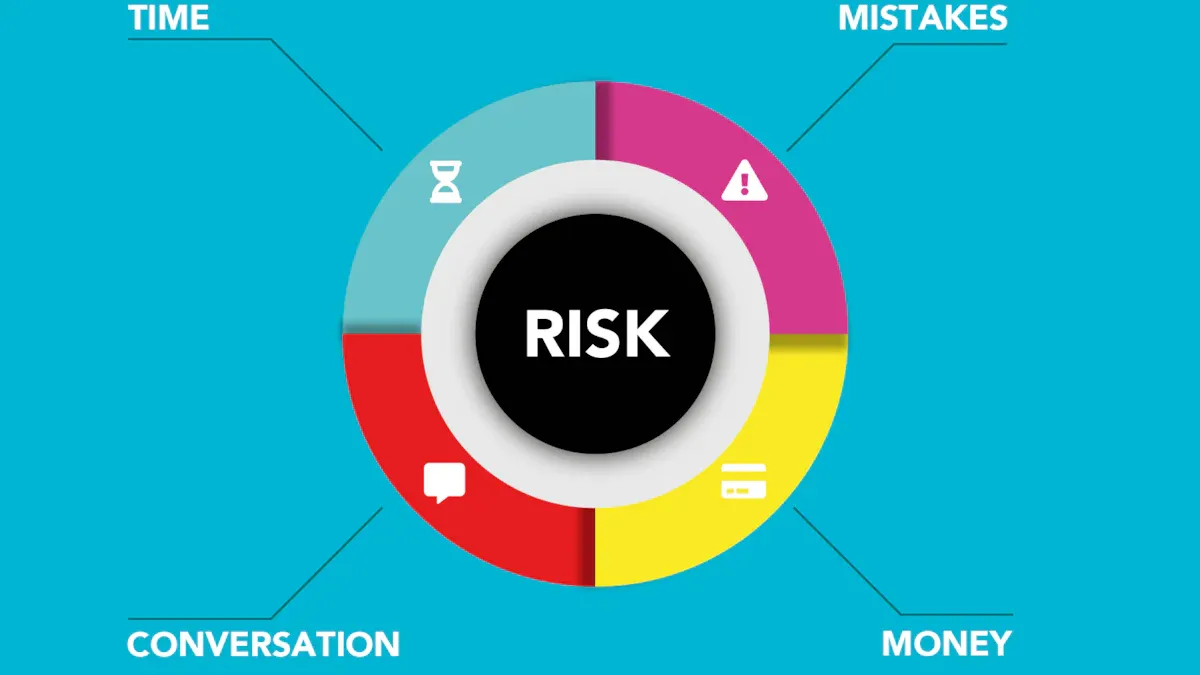- EasyCard
- Trade
- Help
- Announcement
- Academy
- SWIFT Code
- Iban Number
- Referral
- Customer Service
- Blog
- Creator
Protective Call Option: An In-Depth Analysis of an Advanced Trading Strategy to Limit Short Selling Risks

Image Source: pexels
When you short stocks, the greatest risk you face is the potential for unlimited stock price increases, leading to substantial losses. In Q2 2024, short interest in the U.S. and Canadian markets increased by nearly $58 billion, indicating heightened short-selling activity during volatile periods.
The protective call option helps you lock in a maximum loss by purchasing a call option, enabling effective risk management. This strategy provides you with greater security when facing unpredictable markets.
Key Takeaways
- The protective call option effectively limits short-selling risk. By purchasing a call option, you can cap your maximum loss, avoiding potential losses from unlimited stock price increases.
- Choosing the right option contract is critical. Pay attention to asset volatility, option premiums, and strike prices to optimize risk management and cost control.
- During heightened market volatility, the protective call option provides additional protection. This strategy is suitable for investors looking to safeguard their portfolios in uncertain markets.
- Regularly review strategy performance and adjust option parameters promptly. Monitor transaction costs and market changes to maximize risk management effectiveness.
Protective Call Option and Short-Selling Risk

Image Source: unsplash
Strategy Principle
When you short stocks, the greatest risk comes from the potential for unlimited stock price increases. Theoretically, stock prices have no upper limit, meaning your potential losses are also unlimited. The protective call option helps you effectively hedge this risk. While establishing a short position, you purchase a call option on the same underlying asset. If the stock price suddenly surges, you can exercise the call option to buy the stock at the agreed-upon price, thereby limiting losses.
The core of this strategy lies in “locking in maximum losses.” You only need to pay a certain premium for the call option (typically in USD) to gain hedging protection. Even in extreme market conditions, your losses will not exceed the sum of the short-selling loss and the option premium. You can view the protective call option as purchasing insurance for your short position.
In practice, you will find the structure of the protective call option to be highly flexible. You can choose different strike prices and expiration dates based on your risk tolerance and market judgment. This allows you to participate in the profits from market declines while avoiding significant losses due to sudden price surges.
Risk Limitation Mechanism
You may wonder how effectively this strategy controls risk. The table below provides a clear comparison of the risk and reward profiles of naked short-selling versus the protective call option under different market scenarios:
| Naked Short-Selling | Protective Call Option | |
|---|---|---|
| Risk | Unlimited — If the underlying asset’s price continues to rise, losses have no upper limit. | Limited — Maximum loss is the short-selling loss plus the call option premium. |
| Reward | Limited — Maximum profit is the short-selling price minus the buyback price. | Unlimited — Theoretically, maximum profit has no upper limit, depending on the extent of the asset’s price decline. |
| Maximum Profit Scenario | The underlying asset’s price significantly declines. | The underlying asset’s price significantly declines, and the option is not exercised. |
| Maximum Loss Scenario | The underlying asset’s price significantly rises. | The underlying asset’s price significantly rises, but losses are capped by the call option. |
You can see that the greatest advantage of the protective call option is “limited risk.” Even in extreme market reversals, your losses will not grow indefinitely. You only bear the cost of the option premium to gain this protection. For investors looking to short in uncertain market conditions, this strategy offers a higher margin of safety.
Tip: In the U.S. market, many professional investors and institutions use protective call options to manage short-selling risk. You can also adjust option parameters flexibly based on your investment goals to enhance overall risk control.
Strategy Composition
Short-Selling and Option Combination
When building a protective call option strategy, you need to combine a short position with a call option effectively. The specific process is as follows:
- You first establish a short position, selling stocks you do not own in the market, expecting to buy them back at a lower price later.
- Simultaneously, you purchase a call option on the same underlying asset. If the stock price rises, you can use the option to buy the stock at the agreed-upon price, limiting losses.
- You calculate the initial cash flow. The initial cash flow equals the funds received from short-selling minus the premium paid for the call option (in USD).
- At expiration, you calculate the total profit or loss based on the relationship between the stock price and the option’s strike price.
- You can determine the break-even point by subtracting the option premium from the initial stock price.
- You also need to choose an appropriate strike price and expiration date based on your risk tolerance and market expectations.
By adopting this combination, you can profit from market declines while using the call option to cap maximum losses, avoiding uncontrollable risks from extreme market conditions.
Contract Elements
When selecting a contract for the protective call option, you need to focus on the following key elements:
- Asset Value Protection: You should prioritize stocks with high volatility and significant downside risk as the underlying asset.
- Income Generation: You can use the funds obtained from short-selling to partially offset the cost of the option premium.
- Volatility Management: You should monitor market volatility indices (e.g., VIX), as high volatility makes protective strategies more suitable.
- Cost Optimization: You can balance protection strength and option costs by choosing different strike prices.
- In-the-money strike prices offer maximum protection but come with higher premiums.
- Out-of-the-money strike prices have lower premiums but provide limited protection.
- At-the-money strike prices balance protection and cost.
You need to select an appropriate option contract based on your portfolio’s risk exposure. You should also calculate the coverage ratio for each position and match the option’s strike price with your investment cost basis. This allows you to manage overall risk more scientifically.
Applicable Scenarios
Market Environment
When choosing a protective call option, you should pay attention to market volatility and uncertainty. This strategy performs exceptionally well in the following environments:
- During heightened market volatility, you can use the protective call option to reduce risks from extreme market conditions.
- When you expect short-term market declines but remain confident in the long-term outlook, this strategy helps you cap maximum losses.
- If you are concerned about sudden events causing sharp price fluctuations, the protective call option provides additional protection for your short position.
You can refer to the table below to understand the impact of the protective call option on profit and loss in different market scenarios:
| Scenario | Outcome | Description |
|---|---|---|
| Stock trades at $100 at expiration | Option expires | You keep the stock, with a loss of $600 for the option premium. |
| Stock trades at $80 at expiration | Exercise option | You sell the stock at the $90 strike price, with an actual sale price of $88, capping the maximum loss at $3,600. |
| Stock trades above $100 at expiration | Option expires | You keep the stock, with a loss of $600 for the option premium, while benefiting from stock appreciation. |
When encountering high volatility or uncertainty in the U.S. market, using the protective call option can effectively control risk, avoiding uncontrollable losses due to market reversals.
Investor Types
If you fall into the following categories, you may consider using the protective call option:
- You aim to protect your portfolio during market downturns, avoiding the unlimited risk of a single short position.
- You are bullish on a stock’s long-term prospects but concerned about short-term price fluctuations and want to cap maximum losses.
- You are an institutional investor or professional trader needing to hedge large short positions to enhance overall risk management.
- You engage in cross-asset allocation in the U.S. market and wish to optimize your portfolio’s safety margin through option tools.
By adopting the protective call option, you can not only profit from market downturns but also gain greater security in uncertain environments. This strategy is suitable for investors prioritizing stability and risk control.
Profit and Loss Analysis

Image Source: pexels
Risk and Reward
When using the protective call option, you can clearly see the boundaries of risk and reward. Short-selling stocks inherently exposes you to unlimited loss risk, but adding a call option strictly limits your maximum loss. The table below illustrates your profit and loss changes under different market conditions:
| Market Condition | Outcome Description |
|---|---|
| Stock Price Declines | If the stock price falls below $11, you profit from short-selling, with the loss limited to the cost of the call option. |
| Stock Price Rises | If the price exceeds $11, the call option gains value, capping your losses. |
| Maximum Loss | The protective call option limits your maximum loss to $26, which is critical for risk control. |
You can see that, regardless of market fluctuations, the protective call option helps you cap maximum losses. You only bear the option premium to avoid significant losses from extreme market conditions. This strategy provides greater security while pursuing short-selling profits.
Option Cost Impact
In practice, you must pay attention to the cost of the call option. The option premium directly affects your overall returns. The specific impacts are as follows:
- The cost of purchasing a call option limits your potential upside returns, but it provides downside risk hedging.
- The premium paid for the call option is a key factor in determining the strategy’s net profit or loss, affecting the break-even point and maximum achievable returns.
- If the stock price at expiration is above the call option’s strike price, you may be assigned to exercise, with profits being the cap price minus the stock purchase price, plus the cash flow from establishing the hedge.
When formulating the strategy, you should carefully evaluate the balance between option costs and risk protection. Only then can you manage portfolio risk more effectively in the U.S. market.
Operational Process
Step-by-Step Breakdown
When implementing the protective call option strategy, you can follow these steps:
- You select a stock in the U.S. market expected to decline and initiate a short trade. You sell the stock in the market, receiving initial funds (in USD).
- You purchase a call option for your short position on the same underlying asset. You need to choose an appropriate strike price and expiration date based on your risk tolerance and budget. The premium is paid in USD.
- You continuously monitor market price changes. If the stock price declines, you can buy back the stock at an appropriate time, earning short-selling profits. At this point, the call option may expire, and you only bear the premium cost.
- If the stock price rises beyond your expectations, you can exercise the call option to buy the stock at the agreed-upon price, capping maximum losses.
- At expiration, you settle all positions and calculate the final profit or loss. You need to consider short-selling profits, option premiums, and exercise costs comprehensively.
At each step, you should monitor market volatility and option contract parameters to better manage risk.
Case Study
Suppose you are bearish on XYZ Company stock in the U.S. market, currently priced at $100. You decide to short 100 shares and simultaneously purchase a call option with a $105 strike price, expiring in one month, with a premium of $2 per share, totaling $200.
| Step | Action | Outcome |
|---|---|---|
| 1 | Short 100 shares of XYZ at $100 | Receive $10,000 in funds |
| 2 | Purchase a call option with a $105 strike price, premium $200 | Pay $200 |
| 3 | Stock price falls to $90 | Buy back the stock, earning $1,000 profit, option expires, net profit $800 |
| 4 | Stock price rises to $110 | Exercise the option to buy the stock at $105, loss of $500, plus premium, total loss $700 |
Through the protective call option, you successfully cap your maximum loss. Regardless of market fluctuations, you can clearly understand your risk boundaries.
Strategy Advantages
Risk Management
When using the protective call option, you can significantly enhance your portfolio’s safety. This strategy provides an effective risk barrier for your short position. You can experience its advantages in the following aspects:
- You can limit potential losses, no longer worrying about significant risks from unlimited stock price increases.
- You gain a safety net during price surges, ensuring your losses have an upper limit even in sudden market reversals.
- You can still profit from price declines while mitigating the impact of market volatility.
You can compare the protective call option with other common risk management tools to further understand its unique value:
| Strategy | Purpose | Risk-Reward Profile |
|---|---|---|
| Covered Call | Generate income | Profits are limited to the strike price plus the premium received |
| Protective Put | Protect against downside risk | Limits downside risk, with unlimited potential returns |
You will find that the protective call option has unique advantages in limiting short-selling risk. You can participate in profits from market declines while effectively guarding against extreme market conditions.
Considerations
When implementing the protective call option, you need to pay attention to key details. Transaction costs and bid-ask spreads directly affect your net returns. You should note the following:
- High transaction costs can reduce your profitability, as these fees erode the profits gained through the option.
- The bid-ask spread represents the actual cost of entering and exiting positions, which may further reduce your returns.
- When evaluating the protective call option strategy, you must account for these costs to ensure net returns cover the risks undertaken.
Tip: When selecting option contracts, prioritize highly liquid U.S. stocks to reduce the impact of bid-ask spreads. You should also regularly review strategy performance and adjust parameters promptly to adapt to market changes.
By using the protective call option, you can effectively limit short-selling risk and enhance portfolio safety. You should rationally evaluate the strategy’s suitability based on your goals and market conditions.
- If you do not expect significant stock price fluctuations or trade in a tax-advantaged account, this strategy is more advantageous.
- You need to monitor transaction fees and tax regulations to control costs reasonably.
| Key Point | Description |
|---|---|
| Reward vs. Risk | The protective call option protects downside only within the premium range, with the investment still carrying capital loss risk. |
| Transaction Costs | Multi-leg option orders are charged per contract, with complex orders incurring higher fees. |
In practice, you should regularly review strategy performance to ensure risk management effectiveness.
FAQ
Is the protective call option suitable for beginner investors?
You can use the protective call option, even as a beginner. You only need to understand basic short-selling and option knowledge. You can practice through simulated trading to gradually master the process.
How much is the option premium typically, and does it affect returns?
The premium you pay varies depending on the underlying asset and market volatility. You need to pay in USD. The premium reduces your final returns but effectively limits risk.
Can I close my position early if the market fluctuates significantly?
You can close your position at any time. You can choose to buy back the stock or sell the option. This allows you to lock in profits or reduce losses early.
What is the difference between a protective call option and a protective put option?
| Strategy Type | Protection Direction | Applicable Scenario |
|---|---|---|
| Protective Call Option | Short-selling risk | Used when you short stocks |
| Protective Put Option | Stock holding downside risk | Used when you hold stocks |
Which platforms can I use to trade protective call options?
You can trade through major U.S. securities brokers or licensed Hong Kong bank investment platforms. You need to ensure the platform supports U.S. stock option trading and understand related fees.
You have gained deep insight into the Protective Call strategy, understanding that risk management and capital efficiency are equally vital when shorting US stocks. In options trading, real-time exchange rates, low transaction fees, and rapid fund settlement are key factors in executing your hedge strategy effectively and locking in profits.
Traditional cross-border methods, such as trading US stock options through licensed banks in Hong Kong, often encounter high remittance fees, complex processes, and non-transparent exchange conversions. These issues not only eat into the potential returns from your sophisticated strategy but can also delay you from seizing fleeting trading opportunities.
BiyaPay eliminates these pain points. We offer real-time exchange rate inquiry and conversion for fiat currencies and remittance fees as low as 0.5%, helping you significantly cut transaction costs. With BiyaPay, you can easily switch between various fiat and cryptocurrencies and participate in global financial markets, including Stocks and options, all on one platform—without needing an overseas account. Your funds can be remitted and arrive within the same day. Click on Real-time Exchange Rate now, BiyaPay for quick registration, and elevate your advanced trading strategies to the next level with lower costs and higher efficiency.
*This article is provided for general information purposes and does not constitute legal, tax or other professional advice from BiyaPay or its subsidiaries and its affiliates, and it is not intended as a substitute for obtaining advice from a financial advisor or any other professional.
We make no representations, warranties or warranties, express or implied, as to the accuracy, completeness or timeliness of the contents of this publication.




Contact Us
Company and Team
BiyaPay Products
Customer Services
is a broker-dealer registered with the U.S. Securities and Exchange Commission (SEC) (No.: 802-127417), member of the Financial Industry Regulatory Authority (FINRA) (CRD: 325027), member of the Securities Investor Protection Corporation (SIPC), and regulated by FINRA and SEC.
registered with the US Financial Crimes Enforcement Network (FinCEN), as a Money Services Business (MSB), registration number: 31000218637349, and regulated by FinCEN.
registered as Financial Service Provider (FSP number: FSP1007221) in New Zealand, and is a member of the Financial Dispute Resolution Scheme, a New Zealand independent dispute resolution service provider.




















